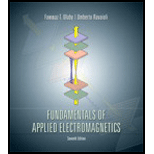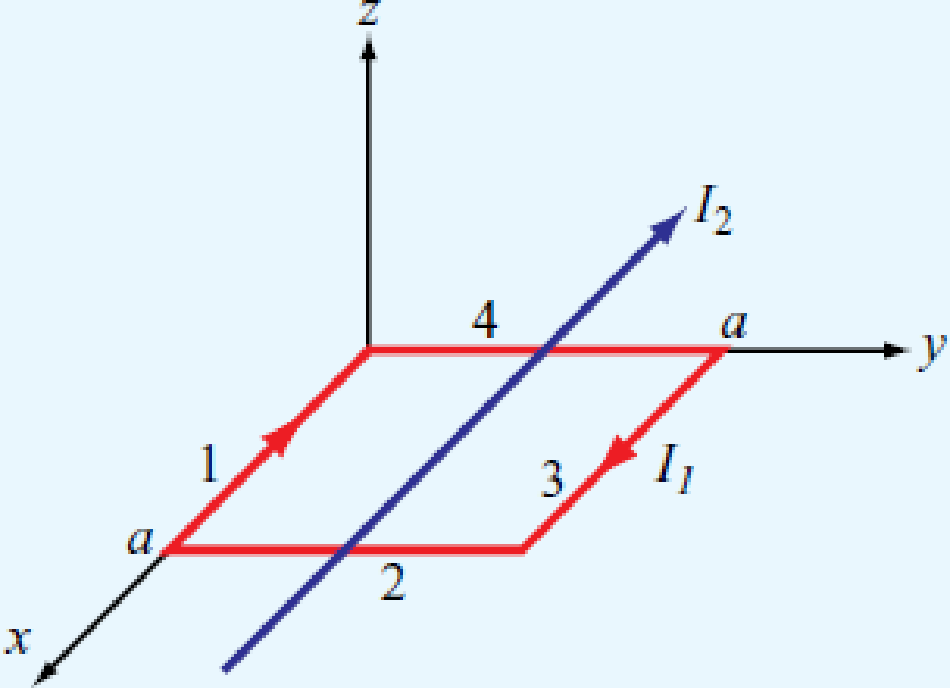
Fundamentals of Applied Electromagnetics (7th Edition)
7th Edition
ISBN: 9780133356816
Author: Fawwaz T. Ulaby, Umberto Ravaioli
Publisher: PEARSON
expand_more
expand_more
format_list_bulleted
Concept explainers
Textbook Question
Chapter 5, Problem 20P
A square loop placed as shown in Fig. P5.20 has 2 m sides and carries a current I1 = 5A. If a straight, long conductor carrying a current I2 = 10A is introduced and placed just above the midpoints of two of the loop’s sides, determine the net force acting on the loop.

Expert Solution & Answer
Trending nowThis is a popular solution!

Students have asked these similar questions
Goal:The intent of this problem is to understand how electrostatic models can be used outside of electrical engineering. This basic model is used to understand chemical
reactions, bonding, and other forms of atomic processes. It also shows you the strength of electrostatic forces in an atom.
The Thomson model of a hydrogen atom is a sphere of positive charge with radius Ro with an electron (a point charge) at its center. The total positive charge equals the electronic
charge q. What is the force of attraction between an electron at a distance R from the center of the sphere of positive charge?
OOOO
qR
4π€, Ro
O
q²R
3πEO
q²R
4π€, Ro
A coil consists of 100 turns of wire in shape of circle placed in the y-z plane. The loop has an area of 1m2
Two magnetic fields linking the surface of the loop:
The first one is given by: B1 = –10t²
The second one is B2 = 20isin(2w)t
Find vtr
emf
Select one:
O a. vtr
2000t – 4000.w.cos(2w)t
emf
O b. 0
O c. vtr
emf
= -20t + 40.w.cos(2w)t
O d. vtr
-2000t + 4000.w. cos(2w)t
emf
O e. vtr
emf
20t – 40.w.cos(2w)t
O f. vtr = 20t
emf
O g. vemf
- 40.w.cos(2w)t
%3D
Both the Biot-Savart and Coulomb's laws exhibit an inverse-square relationship
between field and source.?
True
O False
Chapter 5 Solutions
Fundamentals of Applied Electromagnetics (7th Edition)
Ch. 5.1 - What are the major differences between the...Ch. 5.1 - Prob. 2CQCh. 5.1 - How is the direction of the magnetic moment of a...Ch. 5.1 - If one of two wires of equal length is formed into...Ch. 5.1 - An electron moving in the positive x direction...Ch. 5.1 - A proton moving with a speed of 2 106 m/s through...Ch. 5.1 - A charged particle with velocity u is moving in a...Ch. 5.1 - A horizontal wire with a mass per unit length of...Ch. 5.1 - A square coil of 100 turns and 0.5 m long sides is...Ch. 5.2 - Two infinitely long parallel wires carry currents...
Ch. 5.2 - Devise a right-hand rule for the direction of the...Ch. 5.2 - What is a magnetic dipole? Describe its magnetic...Ch. 5.2 - Prob. 6ECh. 5.2 - A wire carrying a current of 4 A is formed into a...Ch. 5.2 - Prob. 8ECh. 5.3 - What are the fundamental differences between...Ch. 5.3 - Prob. 9CQCh. 5.3 - Compare the utility of applying the BiotSavart law...Ch. 5.3 - Prob. 11CQCh. 5.3 - A current I flows in the inner conductor of a long...Ch. 5.3 - The metal niobium becomes a superconductor with...Ch. 5.5 - What are the three types of magnetic materials and...Ch. 5.5 - What causes magnetic hysteresis in ferromagnetic...Ch. 5.5 - Prob. 14CQCh. 5.5 - The magnetic vector M is the vector sum of the...Ch. 5.6 - With reference to Fig. 5-24, determine the single...Ch. 5.7 - Prob. 15CQCh. 5.7 - What is the difference between self-inductance and...Ch. 5.7 - Prob. 17CQCh. 5.7 - Use Eq. (5.89) to obtain an expression for B at a...Ch. 5 - An electron with a speed of 8 106 m/s is...Ch. 5 - When a particle with charge q and mass m is...Ch. 5 - The circuit shown in Fig. P5.3 uses two identical...Ch. 5 - The rectangular loop shown in Fig. P5.4 consists...Ch. 5 - In a cylindrical coordinate system, a 2 m long...Ch. 5 - Prob. 6PCh. 5 - Prob. 7PCh. 5 - Prob. 8PCh. 5 - The loop shown in Fig. P5.9 consists of radial...Ch. 5 - An infinitely long, thin conducting sheet defined...Ch. 5 - An infinitely long wire carrying a 25 A current in...Ch. 5 - Prob. 12PCh. 5 - Prob. 13PCh. 5 - Prob. 14PCh. 5 - A circular loop of radius a carrying current I1 is...Ch. 5 - Prob. 16PCh. 5 - Prob. 17PCh. 5 - Prob. 18PCh. 5 - Three long, parallel wires are arranged as shown...Ch. 5 - A square loop placed as shown in Fig. P5.20 has 2...Ch. 5 - Prob. 21PCh. 5 - Prob. 22PCh. 5 - Repeat Problem 5.22 for a current density J=zJ0er.Ch. 5 - In a certain conducting region, the magnetic field...Ch. 5 - Prob. 25PCh. 5 - Prob. 26PCh. 5 - Prob. 27PCh. 5 - A uniform current density given by J=zj0 (A/m2)...Ch. 5 - A thin current element extending between z = L/2...Ch. 5 - In the model of the hydrogen atom proposed by Bohr...Ch. 5 - Iron contains 8.5 1028 atoms/m3. At saturation,...Ch. 5 - The xy plane separates two magnetic media with...Ch. 5 - Given that a current sheet with surface current...Ch. 5 - In Fig. P5.34, the plane defined by x y = 1...Ch. 5 - The plane boundary defined by z = 0 separates air...Ch. 5 - Prob. 36PCh. 5 - Prob. 37PCh. 5 - A solenoid with a length of 20 cm and a radius of...Ch. 5 - Prob. 39PCh. 5 - The rectangular loop shown in Fig. P5.40 is...Ch. 5 - Determine the mutual inductance between the...
Knowledge Booster
Learn more about
Need a deep-dive on the concept behind this application? Look no further. Learn more about this topic, electrical-engineering and related others by exploring similar questions and additional content below.Similar questions
- A solenoid (made as a long coil) is a type of electromagnet, the purpose of which is to generate a controlled magnetic eld through a coil wound into a tightly packed helix. Starting from rst principles, derive a formula that provides us the self-inductance of a solenoid (with N windings) of length l and cross-sectional area A.arrow_forwardi need the answer quicklyarrow_forwardExplanation: The given statement is half true as steady current can generate the magnetic field but other half is false as the global charge conservation law is also obeyed by steady current. The steady current is the constant flow of charge in an electric wire. As moving charges always generates magnetic field in the neighborhood space. The global charge conservation law states that the total charge is conserved in an isolated system. Steady currents have to obey the law of charge conservation. Consider some region of space completely enclosed by the balloon-like surface S. The surface integral of J over all of S gives the rate at which charge is leaving the volume enclosed. Now if charge forever pours out of, or into, a fixed volume, the charge density inside must grow infinite, unless some compensating charge is continually being created there. But charge creation is just what never happens. Therefore, for a truly time- independent current distribution, the surface integral of J…arrow_forward
- In the Coulomb force expression for the point particles, F=k, 9192 23- ,what is the SI unit of k. ? kg' m O A) 5-C kg m B) sC kg-m kg-m? D) 5c kg*-m? E) 5Carrow_forward1. Inductance. Consider the configuration of a wire with 90° bends as shown below. A small loop, with its sides of length a and width d = a/16 is placed with its plane lying along xz principal plane as shown. Stating all assumptions, determine mutual inductance between the loop and the wire. a/2 9/2 2aarrow_forwardA solenoid displaces a material plunger ferromagnetic at a distance of 1 cm. The inductance of the solenoid in function of the position of the plunger is given by: L(x) = 0,05 – 20000((x – xo)) H, where x ranges from 0 to 0.01 m and Xo = 0.25 m Calculate the maximum force generated in this solenoid for a current of 1 A.arrow_forward
- Q.1 (a) A filament loop that will carry current I is to be bent and take the form of a regular polygon with all sides having the same length. Angle from the centre of any regular polygon to one of its side is given as 2t/n as shown in Figure Q.1(a) where n is the number of sides that the polygon has. The radius of circle circumscribing the polygon is r. Using Biot - Savart's Law, determine magnetic field intensity, H at the centre of the polygon-loop to be designed with respect to n. (5 marks) 2п п r Figure Q.1(a)arrow_forwardA flat circular coil with 10 loops of wire has a diameter of 2.0 cm and carries a current of 0.50 A. It is mounted inside a long solenoid that has 200 loops on its 25-cm length. The current in the solenoid is 2.4 A. Compute the torque required to hold the coil with its axis perpendicular to that of the solenoid.arrow_forwardQ. 7: CLO4-(C3) Find force on the square loop shown in Figure below. Also, find the expression of mutual inductance between square loop and long wire.arrow_forward
- electrostatic potential at a pointarrow_forwardCreate a detailed solution by Identifying the Given, Requirements, Figure/s, and FBD's (Justify your answers if deemed necessary). Box your final answers.arrow_forwardQUESTION 1 a) Two conducting plates are separated by three dielectric materials as shown in Figure Q.1(a) The relative permittivity, &, of the materials filled in the two conducting plates are tabulated in Table Q.1. Find the total capacitance, C of the parallel plates in terms of d₁, d2, A₁, and A₂ by neglecting the fringing effects. The symbols of di, d2, A₁, and A2 are the material thickness and material areas, respectively. A₁ A₂ di d₂ 1 3 2 Figure Q. 1(a) Table Q.1 Material Relative permittivity, &r 1 2.2 2 2.8 3 4.2 Hint: The general capacitance formula of two conducting plates is given as: d where E, A, and d are the permittivity of free space, area of the two conducting plates, and distance between the two conducting plates, respectively. 1arrow_forward
arrow_back_ios
SEE MORE QUESTIONS
arrow_forward_ios
Recommended textbooks for you
 Introductory Circuit Analysis (13th Edition)Electrical EngineeringISBN:9780133923605Author:Robert L. BoylestadPublisher:PEARSON
Introductory Circuit Analysis (13th Edition)Electrical EngineeringISBN:9780133923605Author:Robert L. BoylestadPublisher:PEARSON Delmar's Standard Textbook Of ElectricityElectrical EngineeringISBN:9781337900348Author:Stephen L. HermanPublisher:Cengage Learning
Delmar's Standard Textbook Of ElectricityElectrical EngineeringISBN:9781337900348Author:Stephen L. HermanPublisher:Cengage Learning Programmable Logic ControllersElectrical EngineeringISBN:9780073373843Author:Frank D. PetruzellaPublisher:McGraw-Hill Education
Programmable Logic ControllersElectrical EngineeringISBN:9780073373843Author:Frank D. PetruzellaPublisher:McGraw-Hill Education Fundamentals of Electric CircuitsElectrical EngineeringISBN:9780078028229Author:Charles K Alexander, Matthew SadikuPublisher:McGraw-Hill Education
Fundamentals of Electric CircuitsElectrical EngineeringISBN:9780078028229Author:Charles K Alexander, Matthew SadikuPublisher:McGraw-Hill Education Electric Circuits. (11th Edition)Electrical EngineeringISBN:9780134746968Author:James W. Nilsson, Susan RiedelPublisher:PEARSON
Electric Circuits. (11th Edition)Electrical EngineeringISBN:9780134746968Author:James W. Nilsson, Susan RiedelPublisher:PEARSON Engineering ElectromagneticsElectrical EngineeringISBN:9780078028151Author:Hayt, William H. (william Hart), Jr, BUCK, John A.Publisher:Mcgraw-hill Education,
Engineering ElectromagneticsElectrical EngineeringISBN:9780078028151Author:Hayt, William H. (william Hart), Jr, BUCK, John A.Publisher:Mcgraw-hill Education,

Introductory Circuit Analysis (13th Edition)
Electrical Engineering
ISBN:9780133923605
Author:Robert L. Boylestad
Publisher:PEARSON

Delmar's Standard Textbook Of Electricity
Electrical Engineering
ISBN:9781337900348
Author:Stephen L. Herman
Publisher:Cengage Learning

Programmable Logic Controllers
Electrical Engineering
ISBN:9780073373843
Author:Frank D. Petruzella
Publisher:McGraw-Hill Education

Fundamentals of Electric Circuits
Electrical Engineering
ISBN:9780078028229
Author:Charles K Alexander, Matthew Sadiku
Publisher:McGraw-Hill Education

Electric Circuits. (11th Edition)
Electrical Engineering
ISBN:9780134746968
Author:James W. Nilsson, Susan Riedel
Publisher:PEARSON

Engineering Electromagnetics
Electrical Engineering
ISBN:9780078028151
Author:Hayt, William H. (william Hart), Jr, BUCK, John A.
Publisher:Mcgraw-hill Education,
03 - The Cartesian coordinate system; Author: Technion;https://www.youtube.com/watch?v=hOgKEplCx5E;License: Standard YouTube License, CC-BY